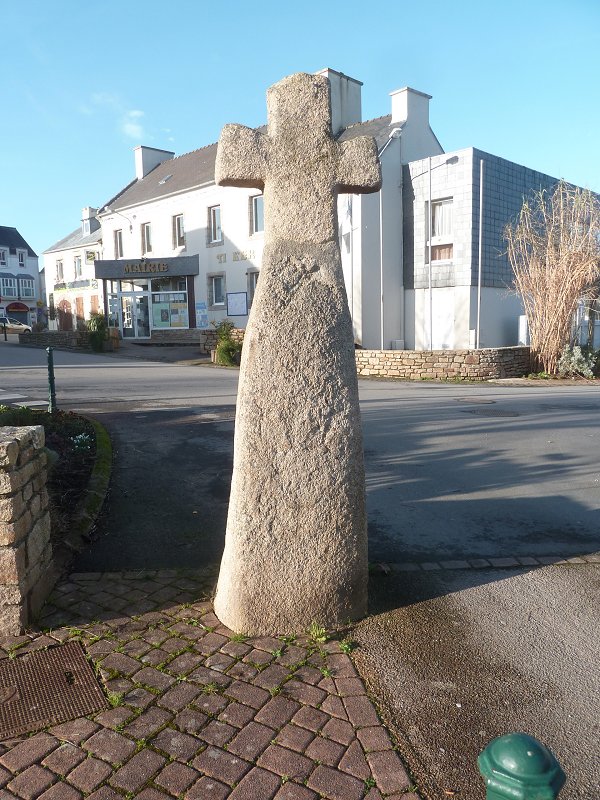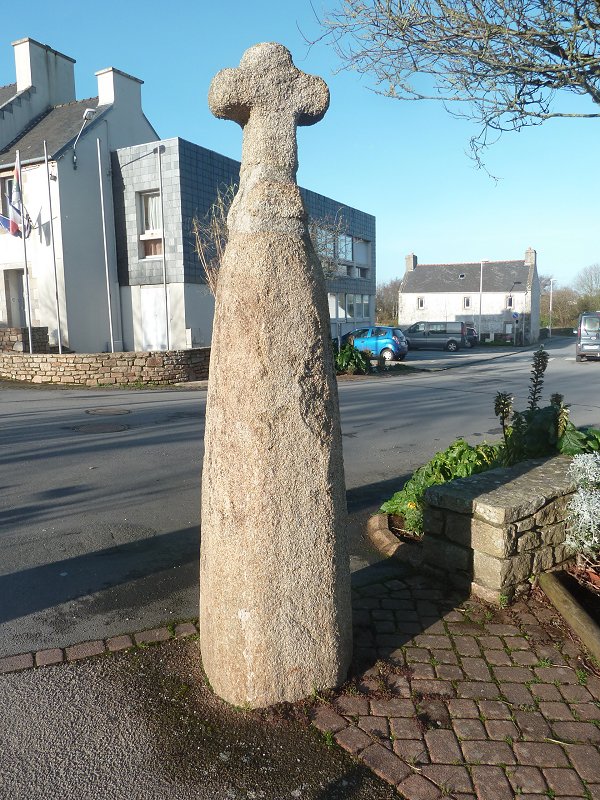Beneath their crowning crosses, two 25-century-old stone steles guard the entrance to the cemetery in front of the church.
Access :
Head towards the church of Locmaria-Plouzané and park on the parking lot behind the two crosses.
Ancient, many and unknown small monuments
See our page dedicated to the stèles gauloises du Second Âge du fer.
Locmaria-Plouzané's two small monuments have been moved many times. The last one took place in 2023, when the square where the parking lot is located was redeveloped.
The stele on the left is a rather crude pyramid trunk, 1.65 m high. Its base is not very regularly trimmed.

The stele on the left before its last move
The one on the right measures 1.95m. Of octagonal section, it has been further worked and presents cut sections that are unfortunately very eroded. It already appeared at the foot of a house in the village on a photograph by M.Y. Daire 1.

The stele on the right before its last move
A traditional right of asylum:
Clearly, these two Iron Age stelae, which bear no resemblance to each other, come from different locations and may not be exactly contemporary either. Their Christianization has preserved them to this day.
In a 1912 study, archaeologist G. Guénin, on the authority of the schoolteacher of the time, points out that the two stones come from Coat ar C'hras, the Bois de la Grâce, so named because commoners, pursued by the lords, were pardoned when they could reach the wood and the two crosses.2 This legend appears in the hagiography of Saint Sané, supposed founder of Plouzané in the V th century, and of which he is the patron saint. It was transmitted to us by the monk Albert Le Grand, hagiographer of the Breton saints, who came to Plouzané in 1624. 3 However, as with many Breton saints, the very existence of Saint Sané has never been historically attested4 and he has often been confused with Saint Senan, an Irish bishop.

Explanatory panel installed in 2023.
-1-
M.Y. Daire: Iron Age steles in western Gaul.p.103. Centre Régional d'Alet. Rennes, 2005.
-2-
Les menhirs isolés de l'arrondissement de Brest by G. Guénin, BSAB, t.37, p 293.
-3-
"Ils advancerent en terre ferme jusques au lieu où est à present l’Église Parrochiale de
Plouzané, où y avoit lors un temple dedié aux Idoles (à ce que j’ay peu découvrir) [...] la Tour de
lieu l’Église Trevialle de Nostre Dame de Lou-Maria, distant de Guic-Sané d’un quart de lieuë, estoit
jadis un Oratoire dedié à leurs fausses & prophanes Deïtez, situé lors au milieu d’une épaisse forest
qu’ils nommoient Lucos ; & void-t-on, devant ladite Église, de part & d’autre du grand chemin, deux
grandes Croix de pierre, lesquelles on tient que S. Sané y avoit fait planter, dés qu’il eust converty ce
peuple à la Foy ; en reconnaissance de quoy, ces Croix ont esté depuis tenues en grande reverence, &
servoient d’Azile & franchise pour les malfacteurs ; que, s’ils pouvoient une fois se rendre au grand
chemin entre ces deux Croix, ils n’estoient point appréhendez de Injustice & l’appelloient Menehy
Sant Sané."
Albert le Grand :
La vie, gestes, mort et miracles des Saints de la Bretagne Armorique, ensemble un catalogue des évêques des neuf eveschés d'icelle
. Nantes 1637.
-4-
See Bernard Tanguy: Grand dictionnaire historique des saints et saintes de Bretagne. Skol Vreizh 2024, p 567.






